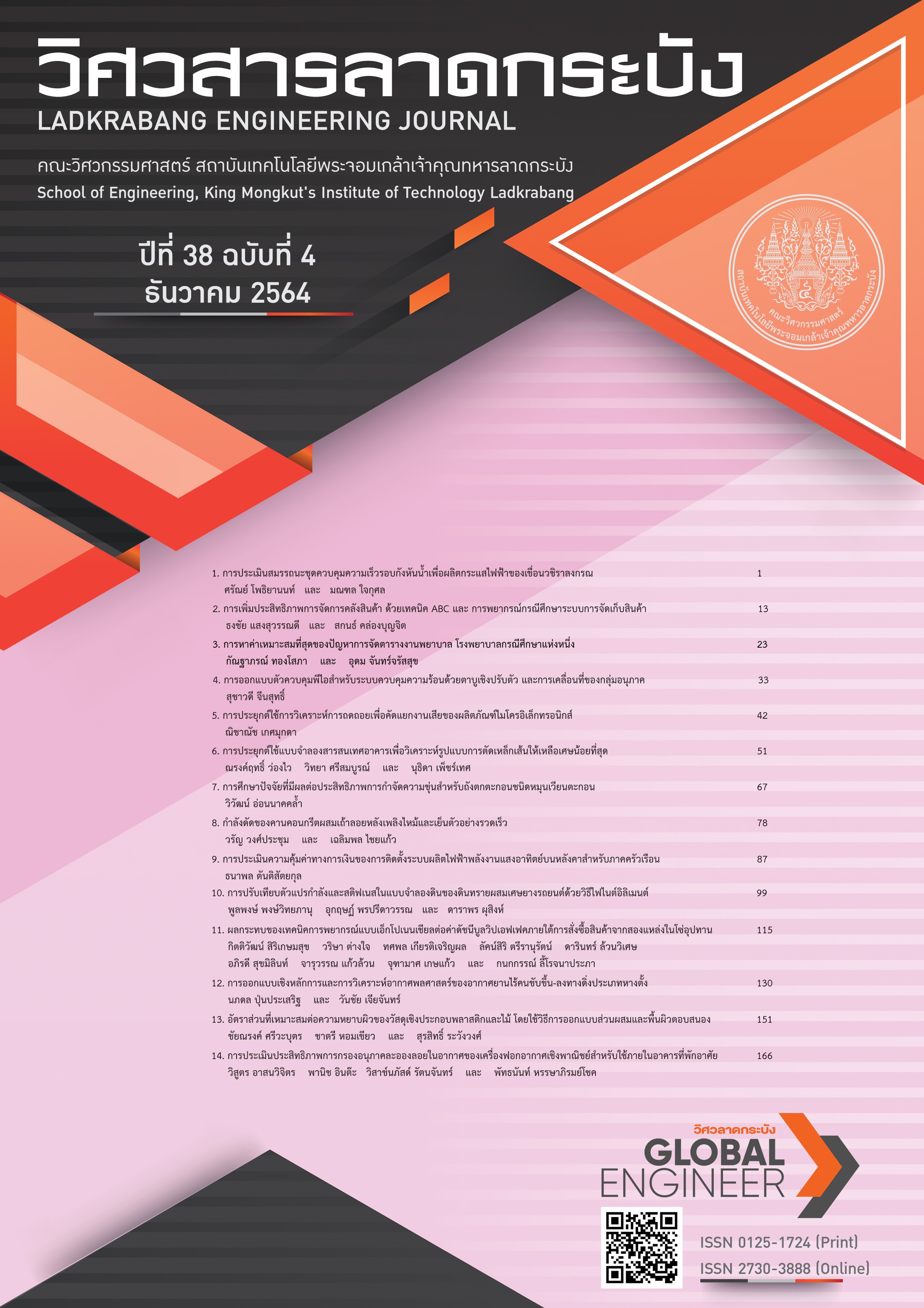A Study of Factor on Turbidity Removal Efficiency for Sludge Recirculation Clarifier
Keywords:
Sludge recirculation clarifier, impeller, scraper, turbidity removal efficiency, water treatmentAbstract
This paper aims to study of factor on turbidity removal efficiency for sludge recirculation clarifier. Aluminum sulphate adding rate and surface loading rate were controlled by 14 mg/l and 3.2 m/h, respectively. The results were compared turbidity removal efficiency by impeller rotating speeds (100, 110, 120 and 130 rev/h) and scraper rotating speeds were varied (0.65, 0.75, 0.85 and 0.95 rev/h). and scraper rotating speeds, Experimental found that impeller rotating speeds, scraper rotating speeds and interaction of impeller rotating speeds and scraper rotating speeds were significantly affected on turbidity removal efficiency. Velocity gradient of impeller rotating speeds and scraper rotating speeds should be controlled in tapered velocity gradient. A fast impeller rotating speed and a slow scraper rotating speed or a slow impeller rotating speed and a fast scraper rotating speed should be set up for maintaining formed floc which affected high turbidity removal efficiency. The best turbidity removal condition was 120 rev/h of impeller rotating speeds and 0.65 rev/hr of scraper rotating speeds, which was 33.2 second-1 of velocity gradient of impeller, 14.7 second-1 of velocity gradient of scraper. And, the best turbidity removal efficiency was 93.19 ± 1.51%.
References
American Water Work Association and American Society of Civil Engineers, “Mixing, Coagulation and Flocculation,” in Water treatment plant design, 4th ed., London, UK: McGraw-Hill, 1990, ch. 6, sec. 6.4-6.5, pp. 112–129.
Y. Tantipalakul, K. Palawatwichai, T. Detchakan and J. Khaisan, “The study of optimal coagulants for water treatment process of Metropolitan Waterworks Authority,” Burabha Journal of Science, vol. 23, no.1, pp. 207–220, Jan., 2018.
S. Eardprapan, “Investigation of Operating Criteria and Efficiency of Sludge Blanket Clarifier at Pangpuay Water Treatment Plant, Rachaburi Province,” M.E. thesis, Dept. Environ. Eng., Kasetsart Univ., Bangkok, Thailand, 2002.
S. Tasutin, “Turbidity Removal from Surface Water by Aluminum Chlorohydrate,” M.S. thesis, Dept. Environ. Sci., Chulalongkorn Univ., Bangkok, Thailand, 2009.
V. Poonsawatt and T. Ratpukdi, “Optimum Alum Dosage for High Turbidity Removal in Water Treatment Plant,” presented at The 20th National Graduate Research Conference, Khon Kaen, Thailand, Mar. 15, 2019 pp. 98–104.
C. Ruenmai, “Factors Affect Quality of Water Supply of Four Communities in Nonthai District, Nakorn Ratchasrima,” M.E. thesis, Dept. Civ. Eng., Suranari Univ. Technol., Nakornratchasrima, Thailand, 2012.
A. Baghvand, A. D. Zand, N. Mehrdadi and A. Karbassi, “Optimizing Coagulation Process for Low to High Turbidity Waters Using Aluminum and Iron Salts,” American Journal of Environmental Science, vol. 6, no. 5, pp. 442–448, 2010.
Z. Zhang, D. Liu, D. Hu, D. Li, X. Ren, Y. Cheng and Z. Luan, “Effect of Slow-Mixing on the Coagulation Performance of Polyaluminum Chloride(PACl),” Chinese Journal of Chemical Engineering, vol. 21, no. 3, pp. 318–323, 2013, doi: 10.1016/S1004-9541(13)60463-2.
M.A. Yukselen and J. Gregory, “The Reversibility of Floc Breakage,” International Journal of Mineral Processing , vol. 73, no. 2–3, pp. 251–259, 2004, doi: 10.1016/S0301-7516(03)00077-2.
V. Thunthithum, “Turbidity Removal by Solids Recirculation Clarifier,” M.E. thesis, Dept. Environ. Eng., Chulalongkorn Univ., Bangkok, Thailand, 1994.
L. Thumkarun, “Effect of Paddle on Turbidity Removal by Solids Recirculation Clarifier,” M.E. thesis, Dept. Environ. Eng., Chulalongkorn Univ., Bangkok, Thailand, 1993.
S. Cheyakul, “Control Parameter of Tapered Flocculation,” M.E. thesis, Dept. Sanit. Eng., Chulalongkorn Univ., Bangkok, Thailand, 1988.
C. C. Dorea, “Coagulant-based emergency water treatment,” Desalination, vol. 248, no. 1–3, pp. 83–90, May, 2009, doi: 10.1016/j.desal.2008.05.041.
A. C. Twort, D. D. Ratnayaka and M. J. Brandt, “Storage, Clarification and Filtration of Water,” in Water supply, 5th ed., Oxford, UK: Butterworth-Heinamann, 2006, ch. 7, sec. 7.13, pp. 267–369.
Who Health Organization, “Acceptability Aspects: Taste, Odour and Apparence,” in Guidelines for Drinking-Water Quality, 4th ed., Geneva, Switzerland: WHO press, 2011, ch. 10, sec. 10.1, pp. 219–230.
P. T. Spicer, W. Keller and S. E. Pratsinis, “The Effect of Impeller Type on Floc Size and Structure
during Shear-Induced Flocculation,” Journal of Colloid and Interface Science, vol. 184, no. 1, pp. 112–122, 1996, doi: 10.1006/jcis.1996.0601.
S. Intrto, “Effect of pulsation rate, surface overflow rate and suction height on turbidity removal efficiency of pulsator clarifier,” M.S. thesis, Dept. Sanit. Eng., Mahidol Univ., Nakorn Pathom, Thailand, 2005.
Downloads
Published
How to Cite
Issue
Section
License
Copyright (c) 2021 Faculty of Engineering, King Mongkut’s Institute of Technology Ladkrabang

This work is licensed under a Creative Commons Attribution-NonCommercial-NoDerivatives 4.0 International License.
The published articles are copyrighted by the School of Engineering, King Mongkut's Institute of Technology Ladkrabang.
The statements contained in each article in this academic journal are the personal opinions of each author and are not related to King Mongkut's Institute of Technology Ladkrabang and other faculty members in the institute.
Responsibility for all elements of each article belongs to each author; If there are any mistakes, each author is solely responsible for his own articles.






